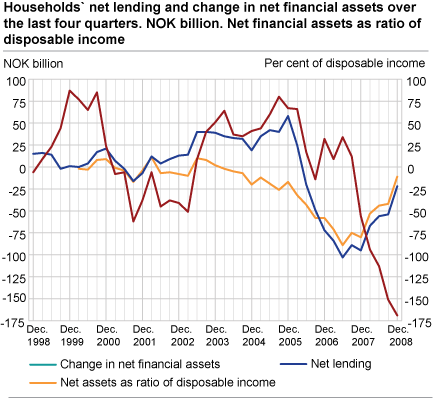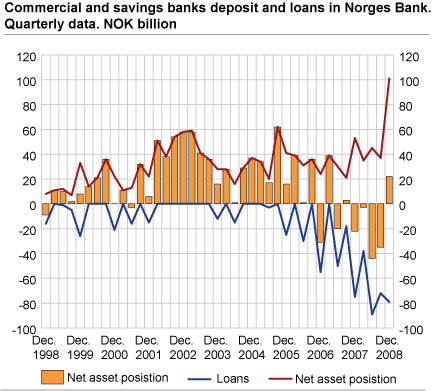Content
Published:
This is an archived release.
Households net lending rose in 2008
The financial accounts for households and non-profit institutions serving households are characterized by increased bank deposits, declining borrowing and holding losses due to quoted development in securities. The financial accounts for local government show increased borrowing and a fall in net lending.
Households net lending rose by NOK 73 billion to NOK -22 billion in 2008. Due to the financial turmoil the market value of households’ net financial assets fell by NOK 147 billion last year and contributed together with negative net lending to a reduction in net financial assets with NOK 169 billion. Households` net financial asset was calculated to NOK 248 billion at the end of 2008.
Rise in net lending contributed to increased saving
Borrowing declined significantly in 2008 and the pace of this development increased in the second half of the year. At the same time bank deposits grew, especially in the fourth quarter of 2008. The development in both bank deposits and loan debt to financial corporations explains most of the improvement in households’ net lending. The main picture in the financial account is consistent with the movement in the non-financial accounts where households’ increased their savings while the fixed capital formation declined in 2008.
High deposits and loans in the Central Bank
Due to the financial turmoil the Central Bank has supplied the commercial and savings banks with liquid means, inter alia by lending (F-loans). In the first three quarters period of 2008 loans to domestic banks exceeded their respective deposits in the Central Bank. Under normal conditions banks have higher deposits than loans in the Central Bank. By the end of the year, the commercial and savings banks’ deposits and loans in the Central Bank constituted NOK 101 billion and NOK 79 billion, respectively. This placed domestic banks in a net lending position of NOK 22 billion to the Central Bank.
High level of net lending and huge losses in the central government
The central governments net lending is calculated at NOK 516 billion in 2008 which is NOK 100 billion higher than in 2007. The high net lending is explained by huge net acquisitions in both domestic and foreign stock exchange markets. During 2008 the Government Pension Fund- Global phased out both repurchase and re-sale agreements in securities, which reduced central governments loans and debt. In spite of increasing financial investments, the quoted development in securities has contributed to a decline in central governments net financial assets by NOK 17 billion.
Lowest recorded level of net lending in local government
The local governments net lending was NOK -25 billion in 2008 and NOK -17 billion in 2007. This development reflects a high level of activity in municipalities with a growth in consumption- and investment expenditures that exceeds growth in income. The local government has increased their borrowing in the last year with NOK 20 billion. It is especially bonds debt that has increased. The local government has deducted their financial assets in 2008 by net sale of securities and a reduction in bank deposits.
Net financial assets abroad increased in 2008
Norway’s net foreign assets were calculated to NOK 1 622 billion at the end of 2008. This is up NOK 180 billion from the end of third quarter of 2008, when net foreign assets were calculated at NOK 1 422 billion. In 2008 Norway’s net lending abroad was NOK 465 billion, while net foreign financial assets increased with NOK 368 billion. The fall in stock market prices contributed negatively to Norway’s net foreign assets, while the weakening of the Norwegian krone contributed positively to the NOK-value of net foreign assets. The net effect in 2008 was net holding losses of NOK 97 billion.
| 4. quarter 2006 | 1. quarter 2007 | 2. quarter 2007 | 3. quarter 2007 | 4. quarter 2007 | 1. quarter 2008 | 2. quarter 2008 | 3. quarter 2008 | 4. quarter 2008 | |||||||||||||||||||||||||||||||
|---|---|---|---|---|---|---|---|---|---|---|---|---|---|---|---|---|---|---|---|---|---|---|---|---|---|---|---|---|---|---|---|---|---|---|---|---|---|---|---|
| Financial assets | 4 978 | 5 280 | 5 368 | 5 369 | 5 532 | 5 377 | 5 483 | 5 809 | 6 471 | ||||||||||||||||||||||||||||||
| Liabillities | 3 703 | 3 998 | 4 072 | 4 117 | 4 277 | 4 136 | 4 270 | 4 367 | 4 849 | ||||||||||||||||||||||||||||||
| Net financial assets / net financial wealth | 1 275 | 1 282 | 1 296 | 1 252 | 1 254 | 1 241 | 1 213 | 1 442 | 1 622 | ||||||||||||||||||||||||||||||
| Change in net financial assets / net financial wealth | -68 | 7 | 14 | -43 | 2 | -13 | -28 | 229 | 180 | ||||||||||||||||||||||||||||||
| Other changes | -169 | -75 | -53 | -138 | -115 | -113 | -151 | 109 | 57 | ||||||||||||||||||||||||||||||
| Net lending | 101 | 82 | 67 | 95 | 117 | 99 | 123 | 120 | 123 | ||||||||||||||||||||||||||||||
DefinitionsNet lending as defined in non - financial accounts ( capital account ) = savings + net capital transfers - net acquisition of non - financial assets Net lending as defined in financial accounts = net acquisition of financial assets - net incurrence of liabilities Savings is non-consumed income and can be invested in financial or non-financial assets. If savings exceed non-financial investments, a sector has a surplus of funds and becomes a net lender to other sectors. In the financial transaction account, this means that the sector acquires more financial assets than liabilities. On the other hand, if savings are less than non-financial investments, investments have to be funded either by selling financial assets or incurring debts. Household investments in non-financial assets mainly reflect the purchase of new housing and fixed investments by unincorporated enterprises. They typically finance substantial parts of these investments by incurring debt in the form of loans. Net financial assets ( net financial wealth ) = total financial assets - total liabilities The financial balance sheet shows the financial position of a sector at the end of the reference period and is broken down into the categories of financial assets and liabilities. Insurance technical reserves, currency and deposits are the predominant assets held by households, while loans provided by financial corporations (banks etc.) constitute the main proportion of liabilities. Changes in net financial assets = net lending + other changes in assets , net The change in the financial balance sheet during the reference period is a result of accumulated financial transactions and other changes in assets. The latter category mainly reflects revaluations due to changes in market prices of financial instruments. |
Contact
-
Torbjørn Cock Rønning
E-mail: torbjorn.cock.ronning@ssb.no
tel.: (+47) 97 75 28 57
-
Jon Ivar Røstadsand
E-mail: jon-ivar.rostadsand@ssb.no
tel.: (+47) 21 09 43 69
-
Marit Eline Sand
E-mail: marit.sand@ssb.no
tel.: (+47) 40 90 26 74


